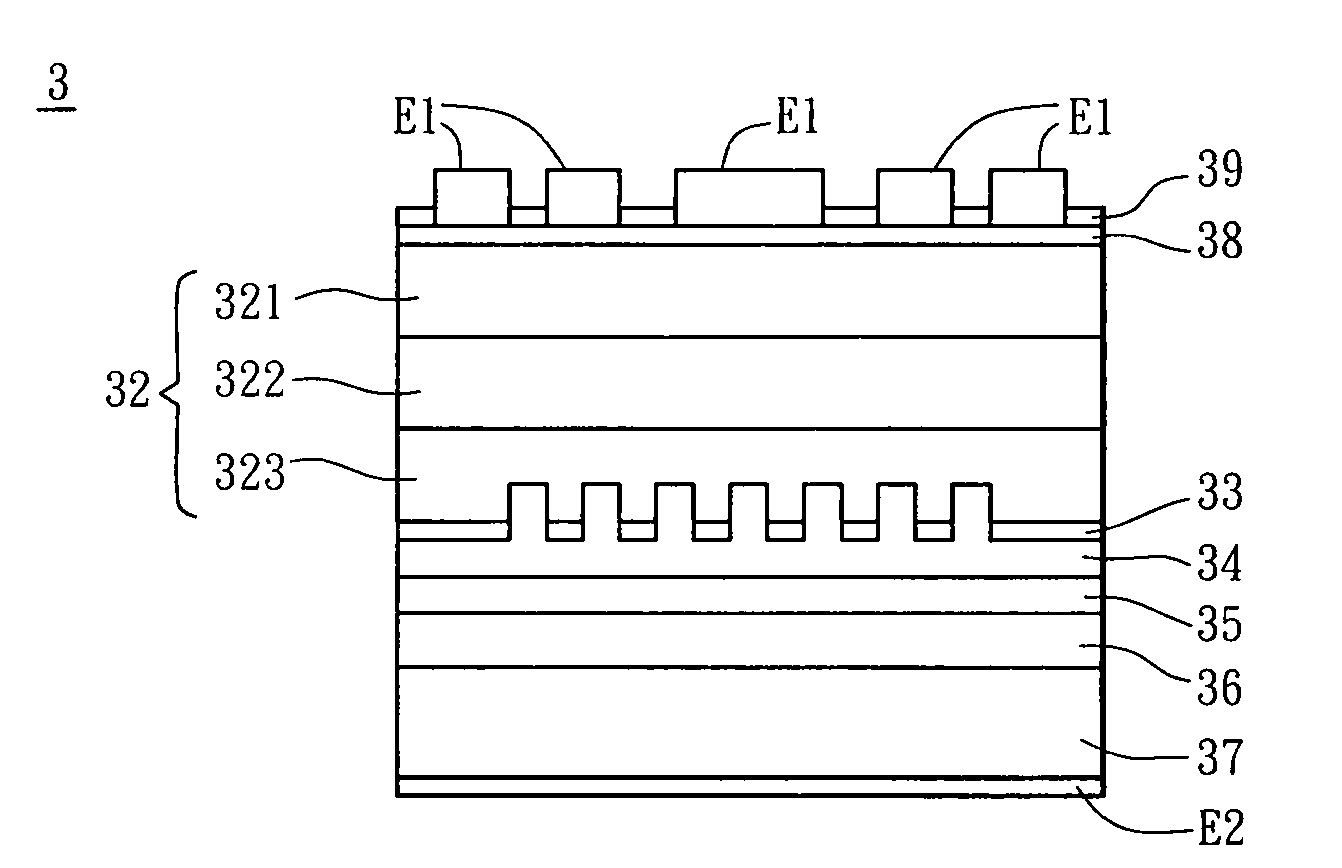Light-emitting diode device and manufacturing method thereof
- Summary
- Abstract
- Description
- Claims
- Application Information
AI Technical Summary
Benefits of technology
Problems solved by technology
Method used
Image
Examples
first embodiment
[0024]With reference to FIG. 2, a manufacturing method of a light-emitting diode (LED) device according to a first embodiment of the present invention includes the steps S101 to S110. Illustrations will be made by referring to FIG. 2 in conjunction with FIGS. 3A to 31.
[0025]As shown in FIG. 3A, the step S101 is to form an epitaxial layer 32 on an epitaxial substrate 31. The epitaxial layer 32 includes a first semiconductor layer 321, a light-emitting layer 322 and a second semiconductor layer 323. The first semiconductor layer 321 is formed on the epitaxial substrate 31. Next, the light-emitting layer 322 is formed on the first semiconductor layer 321. Then, the second semiconductor layer 323 is formed on the light-emitting layer 322. The first semiconductor layer 321 and the second semiconductor layer 323 can be, for example but not limited to, an N-type epitaxial layer and a P-type epitaxial layer, respectively. Of course, the first semiconductor layer 321 and the second semicondu...
second embodiment
[0038]With reference to FIG. 4, a manufacturing method of a light-emitting diode (LED) device according to a second embodiment of the present invention includes the steps S201 to S211. Illustrations will be made by referring to FIG. 4 in conjunction with FIGS. 5A to 5J. Herein, the steps S201 to S203 as shown in FIGS. 5A to 5E are similar to the steps S101 to S103 of the first embodiment, so the detailed descriptions will be omitted.
[0039]In step S204, a reflective layer 35 is formed on the current spreading layer 34, and then an insulating thermoconductive layer 40 is formed on the reflective layer 35. In the embodiment, the material of the insulating thermoconductive layer 40 includes nitride, oxide, carbide, aluminum oxide, silicon carbide or any kind of dielectric materials.
[0040]As shown in FIG. 5F, the step S205 is to form an adhesive layer 36 on a substrate 37. Herein, the material of the adhesive layer 36 is capable of adhering at low temperature and can be a non-conductive ...
third embodiment
[0047]With reference to FIG. 6, a manufacturing method of a light-emitting diode (LED) device according to a third embodiment of the present invention includes the steps S301 to S306. Illustrations will be made by referring to FIG. 6 in conjunction with FIGS. 7A to 7E. Herein, the illustration with reference to FIG. 7A is similar to that described in the previous embodiment, so the detailed descriptions will be omitted.
[0048]In the embodiment, the second semiconductor layer 323 is formed on the light-emitting layer 322 and is etched by a thin-film process, a photolithograph process, an etching process, an electron beam writer (E-beam writer) processing, an anodic aluminum oxidizing (AAO) or using micro-nano particles to the first micro-nano structure 323a as shown in FIG. 7B.
[0049]The first micro-nano structure 323a includes at least one nano-ball, nano-column, nano-hole, nano-point, nano-line, a nano-concave-convex structure, periodic hole or non-periodic hole. In the embodiment, t...
PUM
 Login to View More
Login to View More Abstract
Description
Claims
Application Information
 Login to View More
Login to View More - R&D
- Intellectual Property
- Life Sciences
- Materials
- Tech Scout
- Unparalleled Data Quality
- Higher Quality Content
- 60% Fewer Hallucinations
Browse by: Latest US Patents, China's latest patents, Technical Efficacy Thesaurus, Application Domain, Technology Topic, Popular Technical Reports.
© 2025 PatSnap. All rights reserved.Legal|Privacy policy|Modern Slavery Act Transparency Statement|Sitemap|About US| Contact US: help@patsnap.com



